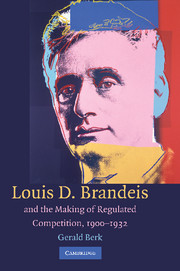Book contents
- Frontmatter
- Contents
- Figures and Tables
- Acknowledgments
- 1 Creative Syncretism
- PART I BRANDEIS AND THE THEORY OF REGULATED COMPETITION
- PART II REGULATED COMPETITION IN PRACTICE
- PART III REGULATED COMPETITION CONTESTED
- PART IV CONCLUSION
- Appendix Industries and Number of Associations with at Least Substantial Involvement in Developmental Association, by Industry Group
- Index
1 - Creative Syncretism
Published online by Cambridge University Press: 23 November 2009
- Frontmatter
- Contents
- Figures and Tables
- Acknowledgments
- 1 Creative Syncretism
- PART I BRANDEIS AND THE THEORY OF REGULATED COMPETITION
- PART II REGULATED COMPETITION IN PRACTICE
- PART III REGULATED COMPETITION CONTESTED
- PART IV CONCLUSION
- Appendix Industries and Number of Associations with at Least Substantial Involvement in Developmental Association, by Industry Group
- Index
Summary
Industrialization imperiled democracy and markets in the United States because it concentrated power in large corporations. Looking back at the Progressive Era, scholars generally see two options: break up corporations or regulate them. There was a third way, which contemporaries called regulated competition. In this framework, the state checked the tendency to concentrated power in the first instance by steering competition from predation into improvements in products and production processes. Louis Brandeis conceptualized regulated competition and introduced it into public debate during the presidential election of 1912.
Political entrepreneurs in Congress enacted many of Brandeis's proposals into law. They licensed the Federal Trade Commission (FTC) to check predatory rivalry before it turned into unassailable power and to cultivate business capacities to improve the quality of competition. The FTC enlisted business and professional associations to make regulated competition workable through better cost accounting and trade practice conferences. Trade associations in specialty manufacturing took up the FTC's challenge, and reinvented themselves from competition-suppressing cartels into developmental associations devoted to enhancing products, services, and productivity. The commercial printing industry showed how developmental associations could succeed. And nearly a third of the manufacturing industries in the United States adopted the tools of regulated competition and developmental association to improve economic performance. By a number of measures, regulated competition better reconciled traditional American aspirations to egalitarian democracy with modern ambitions to economic prosperity than either free markets or regulated corporations.
- Type
- Chapter
- Information
- Publisher: Cambridge University PressPrint publication year: 2009

